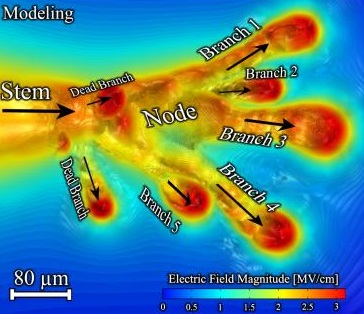New model for streamers in full view
 In extremely small scale technologies for some of the world’s most mind-boggling devices, there are factors at play that can ruin a project from a microscopic scale.
In extremely small scale technologies for some of the world’s most mind-boggling devices, there are factors at play that can ruin a project from a microscopic scale.
Streamers are one of these factors. Streamers are the small trees of electrical discharge we normally only experience as static electricity. They can be powerful enough to cause catastrophic damage to electrical equipment, harm the surrounding environment, and lead to large-scale power outages.
Understanding the tiny flickers of electricity can help prevent the primary origin of electric breakdown.
In a study reported by the Journal of Applied Physics, a team of researchers at MIT have developed an accurate 3-D model of streamer propagation that fully describes and models streamer development, an advance that may impact applications such as medical imaging, aerospace engineering, power transmission, atmospheric sensing, natural sciences, sensing technologies and large-scale industry.
“Our modeling results are understandable even for someone without advanced knowledge of physics, since we have generated very intuitive 3-D plots of streamer tree structures that helps streamer branching mechanisms to be simply inferred,” researcher Jouya Jadidian said. Jadidian's research has been awarded the IEEE Guenther Award and the Chorafas Foundation Award in 2013.
Modelling the streamers required the consideration of many factors. Elements of tangible circuitry can intercede at any point, meaning programmers had to design a way to test every scenario in three dimensions.
The resulting program is huge, creating a massive numerical and processing burden when it is run. Although 3-D imagery in gases is possible on current technology, streamer imaging in liquid dielectrics has proven to be extremely difficult.
“The molecular structure and behavior of liquids are more complex than gases and solids, and even in the purest liquids, there are trace amounts of impurities that make it difï¬cult to isolate the mechanisms behind electrical breakdown,” Jadidian explained.
The results of the research could touch on many fields, allowing engineers and designers to reduce the size of large medical machines such as MRIs and power equipment such as power transformers. The models can be used to create new insulation materials, and identify future potential of plasma treatment technologies such as industrial and medical sterilization of food, surgical equipment and even a surgeon's hands.
The article, "Stochastic and Deterministic Causes of Streamer Branching in Liquid Dielectrics" by Jouya Jadidian, Markus Zahn, Nils Lavesson, Ola Widlund and Karl Borg appears in the Journal of Applied Physics.








 Print
Print